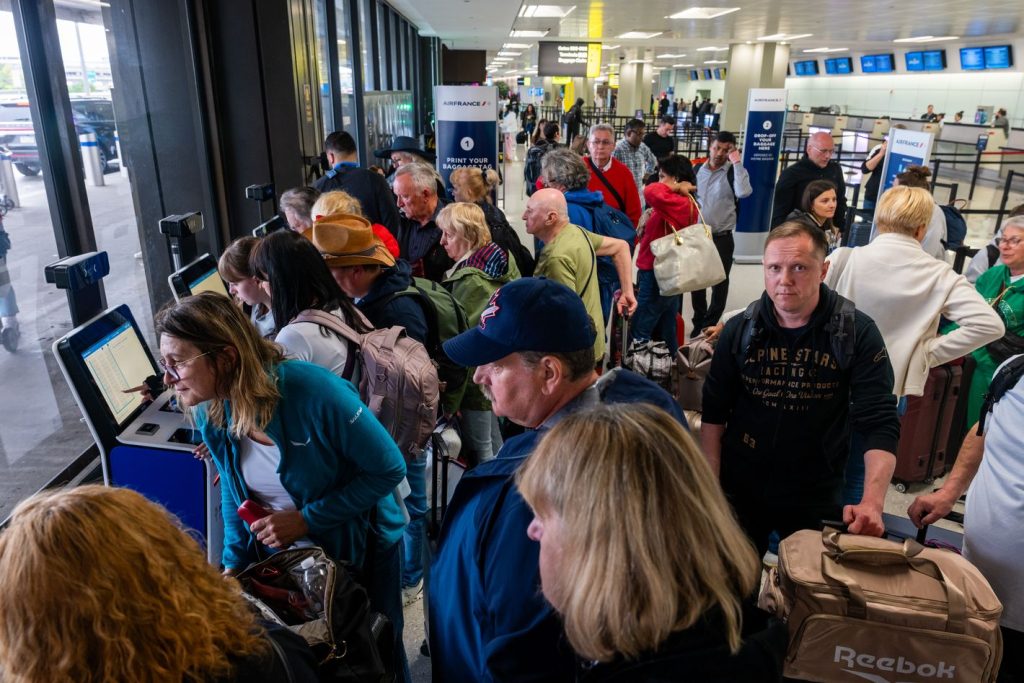Photo: Spencer Platt/Getty Images
Since last Monday, Newark Liberty Airport has been a mess, with as many as 30 percent of flights delayed and 10 percent canceled each day. The acute problem was reported by the press as a walkout among a group of air-traffic controllers who stopped working over the weekend due to chronic labor shortages faced in the industry. One air-traffic controller told MSNBC that it was “not safe to fly” into the nation’s 12th-busiest airport.
A week later, the real cause for the delays — and that controller’s alarm — became known.
Earlier on Monday, April 28, air-traffic controllers were suddenly unable to get in contact with an undisclosed number of planes streaming into Newark. In a statement, the National Air Traffic Controllers Association union said that its controllers “temporarily lost radar and communications with the aircraft under their control, unable to see, hear, or talk to them.” They were unable to contact the planes for about 90 seconds, according to Bloomberg News. A source told the New York Post that the apparent cause was a “piece of fried copper wire.”
There was no backup system to contact the planes during the blackout. Air-traffic controllers had to wait until the system came back on.
“Your only job as an air-traffic controller is to prevent airplanes from colliding,” says Paul Rinaldi, the former NATCA head who currently serves as senior vice-president of operations and safety at the trade group Airlines for America. “Your number one tool to separate airplanes is talking to them via communication, via the frequencies. And if those go out, you have no ability to talk to them or no real ability to discern exactly where these airplanes are. That’s something that should not happen. That’s something that doesn’t happen often.”
According to the union, a crisis like this applies as a “traumatic” event for an air-traffic controller, allowing them to take leave under federal law. The 20 percent of controllers who took leave “did not ‘walk off the job’ as it has been reported by the media,” the NATCA said in a statement.
When the equipment is working, air-traffic control is a high-stakes enterprise ensuring that 45,000 daily flights over U.S. airways land safely and relatively on schedule. But experts say that the field has been held back by a number of political, technological, and staffing issues dating back decades.
“We have the best 1980s technology available,” says Rinaldi, such as the floppy disks that are used in air-traffic control towers across the country. Rinaldi, who formerly worked as a controller and testified before Congress in March, says there’s a computer screen over every controller’s workstation. “Some of them are those old little green computer screens,” he says, referring to the monochrome monitors that provide controllers with information, like bad weather or delays. “Usually every day, they have to update something on it,” he says. “And when they have to update something on it, they use either a five-inch or a three-and-a-half-inch floppy disc.”
The floppy-disk situation is an extreme example of the overall datedness of the air-traffic-control system, but it is hardly the only one. In general, Rinaldi says that the technology used by U.S. air-traffic controllers is like an original iPhone compared to “the rest of the world and rest of modern air-traffic control equipment, which is iPhone 16.” Last year, the Federal Aviation Administration admitted that the average age of an American air-traffic tower was around 40 years. An official at the federal Government Accountability Office testified in March that a third of air-traffic-control systems in the U.S. were considered to be in an “unsustainable” state.
The reasons for the chronic shortage in air-traffic controllers date back to the floppy-disk era as well. Aviation safety consultant Jeff Guzzetti cites the years-long training for controllers as a main reason why airports cannot simply hire more of them during a crisis. “It takes two to three years to train a controller — and that’s after you get them through the Federal Aviation Administration’s academy, where there could be a 40 percent washout rate,” he says.
The job pays well, with a median salary of around $144,000, according to the Bureau of Labor Statistics. “But it takes a certain special person that can mentally picture three dimensions with a bunch of targets moving at different vectors and different speeds,” Guzzetti says. Because of chronic worker shortages, high stress, hard hours, and having to spend a bunch of time at the airport, controllers often complain of exhaustion and overwork.
Newark, in particular, has faced controller shortages over the years. “It is the most congested aerospace in the U.S., and it’s been difficult to get controllers to want to live and work in that New York area,” Guzzetti says. The staffing issue grew worse last year when the FAA transferred Newark’s airspace from a control center in Long Island to Philadelphia — ironically, in an effort to make it easier to hire controllers who might want a lower cost of living.
After the Trump administration fired over 100 safety workers who were not air-traffic controllers in February, Transportation secretary and former Real World contestant Sean Duffy announced plans to “supercharge” the hiring of these federal workers critical to the safe and efficient operation of the aviation system. Perks include cash bonuses for living and working in problem areas like Newark or 20 percent bonuses for controllers who are eligible for retirement who remain on the job. But the baked-in delay due to the required years of training will not solve the acute crisis at Newark.
As flight traffic increases for the summer, both Rinaldi and Guzzetti pushed back on the anonymous air-traffic controller’s claim that it is not safe to fly into Newark. Except for maybe those 90 seconds where air-traffic controllers did not know where the planes were.

